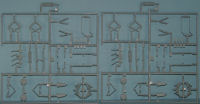
DML 1/72 Apollo 10 Kit First Look
By Michael Benolkin
| Date of Review | March 2012 | Manufacturer | DML |
|---|---|---|---|
| Subject | Apollo 10 | Scale | 1/72 |
| Kit Number | 11003 | Primary Media | Styrene |
| Pros | Beautifully detailed kit | Cons | Poor painting instructions |
| Skill Level | Basic | MSRP (USD) | $53.95 |
First Look
Apollo 10 was the final 'dress rehearsal' before the first attempted landing on the moon. With each previous flight, crews had been testing more aspects of the Apollo spacecraft. Apollo 7 was the first flight of the new spacecraft, especially after the hatch redesign that came out of the fire aboard the Apollo 1. Apollo 8 was the first manned flight to leave Earth orbit, though like Apollo 7, the flight was only made with the Command/Service Module (CSM). It would be Apollo 9 that would first fly with the Lunar Module (LM), though they remained in Earth orbit to perform docking and undocking tests with the new spacecraft. With the success of the CSM and LM, Apollo 10 would fly both craft into Moon orbit where two of the astronauts would descend toward the surface in the LM. At an altitude of 8.5 nautical miles, the crew flew an abort profile back into orbit and rendezvoused with the CSM. The success of this flight led to the first landing by Apollo 11.
 |
 |
 |
 |
 |
 |
I don't know about you, but I've built nearly every Revell and Monogram spacecraft ever made. The Apollo Lunar Landing 1/48 scale kit ranks among my favorites (along with the 1/24 Gemini and the 1/32 Apollo spacecraft). It boggles my mind that these 'timeless' kits are actually quite old, but there hasn't been any other viable spacecraft options to consider - until now.
Dragon Models is doing spacecraft! If you've seen their armor kits, you know how detailed these kits can be so how do they fare with a spacecraft model? Let's take a look. This kit is designed as a display model in the Apollo 10 configuration. The kit is 1/72nd scale and provides for the CSM with escape tower sitting atop a clear fairing that houses a LM in its stowed (landing gear folded) configuration. All of these components rest atop a nice display stand.
Molded in light gray styrene, the kit is presented on 10 parts trees plus a separate LM descent stage. Also included is the clear styrene fairing and two black parts - the base and a small segment of the S-IVB stage. The detailing on this kit is quite impressive! The LM descent stage is covered in gold reflective foil in full-scale and this foil texture is molded into the kit part. All you need to do is paint the foil areas gold!
The engine bells are also impressive - the large main engine bell on the service module as well as the descent engine on the LM are molded as single parts, not halves. The interior of each bell has its reinforcing rings molded in place using some molding magic that is still new to me. Even the smaller attitude engine bells are molded hollow!
Construction of the kit is very simple as there are no interiors in these spacecraft (they're in flight configuration so the hatches are closed and you aren't going to see anything through those tiny windows), so the model assembles very quickly. Even the assembly instructions are covered completely in less than three pages.
This brings me to the best and worst parts of the kit. This is by far the most complete set of markings provided in a spacecraft kit to date. I've spent some good money on aftermarket decals that would provide the level of stenciling and markings that come in this kit. Unfortunately, the instructions in my kit do not have any placement diagrams for these decals.
What's more, the painting instructions sort of show that this given part is 'color F' but the color key doesn't have any associated letters for the list of paints. While paint numbers are provided for the Gunze Sangyo and Model Master series of paints, you don't know which color is associated with which letter. An experienced modeler can use reference photos to paint these spacecraft, but given how well done DML did with this model, the lack painting and decal instructions is disappointing.
Aside from the issue with the instructions, this is the best Apollo display model in 1/72 with perhaps the exception of their pre-finished 1/72 Saturn V and Apollo 11 spacecraft. I saw that beauty at iHobbyExpo and had to get one for myself!
I'm looking forward to tackling this project and add this nice engineering display to my shelf. Look for a build review coming soon!
My sincere thanks to DML for this review sample!







